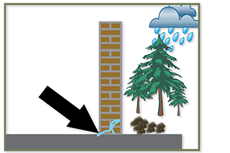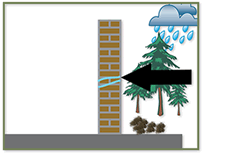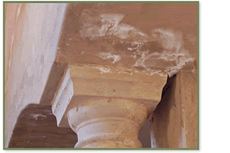COMMON DAMP PROBLEMS
RISING DAMP
Rising damp occurs as a result of capillary suction of moisture from the ground into porous masonry building materials such as stone, brick, earth and mortar. It potentially occurs where there is no damp proof course (DPC) or where the DPC has been damaged or bridged. The height to which the moisture will rise is determined by the evaporation rate and the nature of the wall. The normal limit for rising damp generally ranges from 0.5 to 1.5 meters above ground level. Rising damp may show as a stain on wallpaper and other interior finishes, blistering of paint and loss of plaster. Damp walls encourage the growth of mould, which with high humidity can lead to health problems for occupants. Externally, a damp zone may be evident at the base of walls and in extreme situations, with associated fretting and crumbling of the substrate.
FALLING DAMP
Falling damp is caused by downward water penetration from the top of porous masonry walls. This could be as a result of the top of a boundary wall (coping) not being adequately waterproofed, failed flashings, blocked or leaking gutters, joints that have lost their mortar and the build-up of dirt and moss on upper surfaces of stone or brickwork. Fallen leaves, bird manure, moss and dirt contain weak acids and salts, which if carried by water into masonry can promote decay.
PENETRATING DAMP
Penetrating damp is a common form of damp. It occurs as a result of the horizontal ingress of water through gaps (sometimes tiny) in a building’s substrate. Penetrating or horizontal damp can be due to leaking water pipes and unprotected plaster or brick. Air-conditioning drips and hot water system overflows can also cause problems. Penetrating damp tends to produce localised patches of dampness and decay, whereas rising damp may affect the base of a whole building.
EFFLORESCENCE
Efflorescence is where an appreciable quantity of soluble salts is present in the masonry. It routinely occurs in masonry construction, particularly in brick and typically occurs during the initial curing of the cementitious product. Damp carries these salts up the masonry to where the damp evaporates. As the water evaporates, it leaves the salts behind as a white fluffy deposit. This deposit can normally be brushed off when dry. It usually disappears with time after rains or washing with water. Efflorescence is generally an aesthetic concern and not a structural one. However, where there is excessive efflorescence, the crystallizing salts within the pores of the masonry can disrupt even the strongest material, leading to the fretting and crumbling of the substrate.





